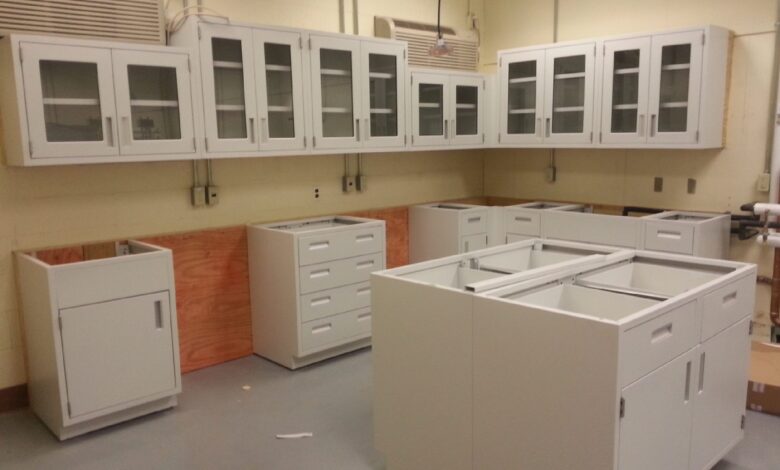The Role of Laboratory Fume Hoods in Chemical Safety: A Comprehensive Guide

In the world of scientific research and experimentation, laboratory safety is of paramount importance. Whether you’re a seasoned chemist or a novice researcher, one of the most critical tools at your disposal for ensuring safety in the laboratory is the laboratory fume hood. This comprehensive guide explores the pivotal role of laboratory fume hoods in chemical safety, providing insights into their design, operation, and maintenance. We’ll also touch on the importance of complementary equipment such as metal lab cabinets in creating a secure and efficient workspace.
Understanding Laboratory Fume Hoods
Laboratory Fume Hood: A Vital Component of Laboratory Safety
Laboratory fume hoods, often referred to as chemical hoods or fume cupboards, are essential fixtures in laboratories where hazardous chemicals are handled. They serve a crucial purpose: to protect researchers and the environment from exposure to harmful chemical fumes, vapors, and airborne particles.
Design and Functionality of Laboratory Fume Hoods
A laboratory fume hood typically consists of an enclosed workspace with a sash or sliding glass panel at the front. The sash can be raised or lowered to control the airflow within the hood. Behind this glass panel, a ventilation system is installed to capture, contain, and exhaust harmful chemical emissions. This airflow effectively prevents noxious substances from escaping into the laboratory environment.
Types of Laboratory Fume Hoods
There are various types of laboratory fume hoods designed to cater to different needs, including:
- General-Purpose Fume Hoods: These are versatile hoods used for a wide range of chemical procedures.
- Ductless Fume Hoods: Suitable for applications where external venting is not feasible, as they contain built-in filtration systems.
- Radioisotope Fume Hoods: Used for handling radioactive materials, these hoods feature additional shielding and specialized filtration systems.
- Perchloric Acid Fume Hoods: Specifically designed for work with perchloric acid, which requires unique construction and corrosion-resistant materials.
- Walk-In Fume Hoods: Larger hoods designed for accommodating larger equipment and conducting experiments on a larger scale.
The Operation of Laboratory Fume Hoods
Laboratory fume hoods operate based on the principle of airflow control. It’s important to understand how to use them correctly to ensure optimal safety:
- Sash Position: Keep the sash of the fume hood as low as possible while working to maintain adequate containment. Raise it only when you need access to the equipment or chemicals inside.
- Airflow Monitor: Some fume hoods are equipped with an airflow monitor to ensure that the hood is functioning correctly. Always check that this monitor is operational.
- Proper Placement: Ensure that the chemicals and equipment you are using are placed at least six inches inside the fume hood. This helps prevent fumes from escaping.
- Face Velocity: Fume hoods are designed to maintain a specific face velocity, which is the speed at which air is drawn into the hood. Ensure this velocity is within the recommended range for effective containment.
- Regular Maintenance: Periodic inspection and maintenance of laboratory fume hoods are essential to keep them functioning optimally. This includes cleaning filters, checking airflow, and verifying the integrity of the hood.
The Role of Metal Lab Cabinets
While laboratory fume hoods are pivotal for containing and exhausting chemical fumes, they are not the only consideration for laboratory safety. Metal lab cabinets are also integral in maintaining a secure and organized workspace. Here’s why they matter:
Chemical Storage and Organization
Laboratories deal with a multitude of chemicals, each with its unique properties and hazards. Metal lab cabinets provide a safe and organized way to store these chemicals, preventing accidental spills or mixing of incompatible substances. They come equipped with chemical-resistant materials and proper ventilation to ensure safety.
Flammable Material Storage
Certain chemicals in laboratories are flammable and require special storage considerations. Metal lab cabinets are available with fire-resistant designs to contain and mitigate the risks associated with storing flammable materials.
Equipment Storage
Laboratory experiments often involve various specialized equipment and tools. Metal lab cabinets offer a secure and convenient storage solution for these items, ensuring they are readily accessible when needed and safely stored when not in use.
Customization and Flexibility
One of the advantages of metal lab cabinets is their ability to be customized to fit the specific needs of a laboratory. From shelving options to drawer configurations, these cabinets can be tailored to suit your unique requirements.
Corrosion Resistance
Chemicals can be corrosive, and metal lab cabinets are designed to resist such corrosion. This not only ensures the longevity of the cabinets but also prevents potential chemical leaks and contamination of the laboratory environment.
Maintenance and Safety Protocols
In addition to understanding the design and function of laboratory fume hoods and the importance of metal lab cabinets, it’s essential to implement proper maintenance and safety protocols. Here are some crucial steps to ensure the safety of your laboratory environment:
- Regular Inspection: Schedule routine inspections of laboratory fume hoods and metal lab cabinets to check for signs of wear and tear, damage, or malfunction. Any issues should be addressed promptly.
- Training and Education: Ensure that all laboratory personnel are adequately trained in the safe use of fume hoods and the proper storage and handling of chemicals.
- Emergency Procedures: Establish clear protocols for handling chemical spills, fires, and other emergencies. Ensure that all laboratory staff are aware of these procedures and know the location of safety equipment, such as eyewash stations and fire extinguishers.
- Ventilation System Maintenance: Regularly service and maintain the laboratory ventilation system to ensure it provides adequate airflow and effectively captures harmful fumes.
- Chemical Compatibility: Store chemicals in a way that prevents incompatible substances from coming into contact with each other. Proper labeling and segregation are key to avoiding chemical reactions that could pose hazards.
- Personal Protective Equipment (PPE): Encourage the use of appropriate PPE, such as gloves, lab coats, safety goggles, and respiratory protection, when working with hazardous chemicals.
Conclusion
Laboratory fume hoods and metal lab cabinets play crucial roles in maintaining a safe and organized laboratory environment. Understanding their design, operation, and maintenance is essential for protecting researchers, the environment, and the integrity of experiments. By following proper safety protocols and investing in high-quality equipment, laboratories can create an environment where scientific discovery can thrive while minimizing risks to all involved.
In summary, the laboratory fume hood and metal lab cabinet are indispensable components of chemical safety in a laboratory setting. Their proper use and maintenance are essential to ensure the well-being of researchers and the integrity of experiments. By prioritizing safety through the correct utilization of these tools, laboratories can continue to be hubs of scientific innovation while minimizing potential hazards.



